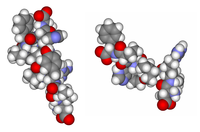
Photo from wikipedia
Objective: Arterial stiffness strongly predicts cardiovascular events and mortality. Hypertension causes the arteries to remodel and potentially stiffen. It is, however, unclear whether this remodeling response differs if hypertension is… Click to show full abstract
Objective: Arterial stiffness strongly predicts cardiovascular events and mortality. Hypertension causes the arteries to remodel and potentially stiffen. It is, however, unclear whether this remodeling response differs if hypertension is induced by adrenergic receptor activation, or by renin-angiotensin-aldosterone system activation. Therefore, the present study aims to compare the aortic remodeling response to hypertension as induced through infusion of norepinephrine (NE) versus infusion of angiotensin II (AngII). Design and method: Adult male C57BL/6J mice were studied under seven conditions: untreated, and after 7, 14, or 28-day subcutaneous infusion of either 3880 ng/kg/min NE or 1000 ng/kg/min AngII. After euthanasia, ascending and descending thoracic (ATA and DTA) and infrarenal abdominal (IAA) aortas were dissected and placed within a computer-controlled biaxial testing device. Aortas were subjected to a series of isobaric (90 mmHg) vasoreactivity experiments to 100 mM potassium chloride, 1 M AngII, 1 M phenylephrine, 10 M acetylcholine (on top of phenylephrine), and 1 mM L-NAME (on top of acetylcholine and phenylephrine). Under passive conditions, pressure-diameter tests were then performed at 95%, 100%, and 105% of the in vivo axial stretch and axial force-length tests at 10, 60, 100, and 140 mmHg. Data were fit using a nonlinear constitutive model. Results: Figure shows passive biomechanical metrics for all seven groups (bar charts, n = 4–8 per group), calculated at in vivo axial stretch and group-specific blood pressures. AngII caused comparatively larger increases in wall thickness than NE. Both NE and AngII led to significant structural arterial stiffening, driven by a combination of wall thickening and stiffening of the wall material. Figure also shows correlation of wall thickness with contractility to L-NAME on top of phenylephrine (scatter plots, n=4–7 per group; symbols represent individual aortas) at a pressure of 90 mmHg. Strikingly, the stronger an individual aorta was able to contract (larger absolute stress change; to the left on x-axis), the weaker its remodeling response. Conclusions: NE- and AngII-induced hypertension elicit distinct aortic remodeling responses. However, independent of the hypertensive stimulus, aortic contractile capacity emerged as protective against hypertensive arterial remodeling.
Journal Title: Journal of Hypertension
Year Published: 2022
Link to full text (if available)
Share on Social Media: Sign Up to like & get
recommendations!